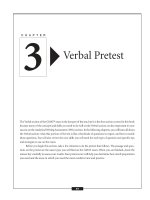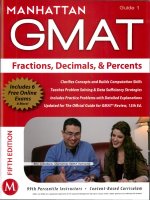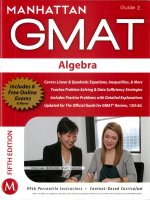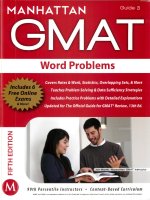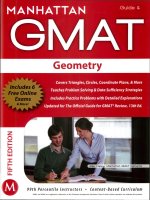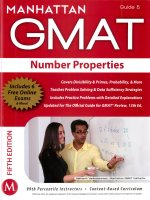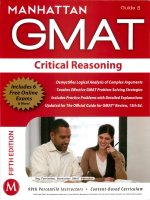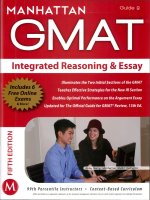Manhattan GMAT - Foundations of GMAT verbal
Bạn đang xem bản rút gọn của tài liệu. Xem và tải ngay bản đầy đủ của tài liệu tại đây (16.2 MB, 378 trang )
MANHATTAN
Strategy Guide
Supplem ent
Foundations of GMAT Verbal
Written by Jennifer Dziura
Builds Core Skills in Grammar; Sentence Structure, & More
Includes
► Online B ^ n u s^
Strengthens Reading Abilities Required for the GMAT
Provides Numerous Drills with Step-by-Step Explanations
Updated for The Official Guide for GM AT đ Review, 13th Ed.
99th Percentile Instructors
ã
Content-Based Curriculum
GMAT and GMAC are registered trademarks of the Graduate Management Admission Council which neither sponsors nor endorses this product.
M A N H A T T A N GMAT
Foundations of GMAT Verbal
GMAT Strategy Guide
This supplemental guide provides in-depth and easy-to-follow
explanations o f the fundamental verbal skills necessary for a strong
performance on the GM AT.
Foundations of GMAT Verbal, Fifth Edition
10-digit International Standard Book Number: 1-937707-01-6
13-digit International Standard Book Number: 978-1-937707-01-9
elSBN: 978-1-937707-14-9
Copyright © 2012 MG Prep, Inc.
ALL RIGHTS RESERVED. No part of this work may be reproduced or used in any form or
by any means— graphic, electronic, or mechanical, including photocopying, recording,
taping, web distribution— without the prior written permission of the publisher,
MG Prep, Inc.
Note: GMAT, Graduate Management Admission Test; Graduate Management Admission
Counciland GMAC are all registered trademarks of the Graduate Management Admission
Council, which neither sponsors nor is affiliated in any way with this product.
Layout Design: Dan McNaney and Cathy Huang
Cover Design: Evyn Williams and Dan McNaney
Cover Photography: Alii Ugosolf
INSTRUCTIONAL GUIDE SERIES
0
G M AT Roadm ap
(ISBN: 978-1-935707-69-1)
Fractions, Decim als, & Percents
0
0
0
□
(ISBN: 978-1-935707-63-9)
N u m b e r Properties
0
(ISBN: 978-1-935707-65-3)
Critical R e a so n in g
0
(ISBN: 978-1-935707-61-5)
A lg e b ra
(ISBN: 978-1-935707-62-2)
W ord P rob lem s
(ISBN: 978-1-935707-68-4)
G e o m e try
(ISBN: 978-1-935707-64-6)
R e a d in g C o m p re h e n sio n
B
(ISBN: 978-1-935707-66-0)
0
0
Sentence Correction
(ISBN: 978-1-935707-67-7)
Integrated R e a so n in g & Essay
(ISBN: 978-1-935707-83-7)
SUPPLEMENTAL GUIDE SERIES
Math GMAT Supplement Guides
Verbal GMAT Supplement Guides
F o u n d atio n s o f G M A T M ath
F o u n d atio n s o f G M A T Verbal
(ISBN: 978-1-935707-59-2)
(ISBN: 978-1-937707-01-9)
A d van ce d G M A T Q u a n t
(ISBN: 978-1-935707-15-8)
O fficial G u id e C o m p a n io n
(ISBN: 978-0-984178-01-8)
MANHATTAN
GMAT
May 29th, 2012
Dear Student,
Thank you for picking up a copy o f Foundations of GMAT Verbal. I hope this book provides just the guidance you
need to get the most out o f your GM AT studies.
As with most accomplishments, there were many people involved in the creation o f the book you are holding. First
and foremost is Zeke Vanderhoek, the founder o f Manhattan GMAT. Zeke was a lone tutor in New York when he
started the company in 2000. Now, 12 years later, the company has instructors and offices nationwide and contributes
to the studies and successes o f thousands o f students each year.
Our Manhattan GM AT Strategy Guides are based on the continuing experiences o f our instructors and students.
For this volume, we are particularly indebted to Jennifer Dziura. Jen has logged literally thousands o f hours helping
students improve their verbal skills— this book is derived from that wealth o f experience. Stacey Koprince and Tommy
Wallach made significant content contributions as well. Dan McNaney and Cathy Huang provided their design
expertise to make the books as user-friendly as possible, and Noah Teitelbaum and Liz Krisher made sure all the mov
ing pieces came together at just the right time. And there’s Chris Ryan. Beyond providing additions and edits for this
book, Chris continues to be the driving force behind all o f our curriculum efforts. His leadership is invaluable.
At Manhattan GMAT, we continually aspire to provide the best instructors and resources possible. We hope that
you will find our commitment manifest in this book. If you have any questions or comments, please email me at
I’ll look forward to reading your comments, and I’ll be sure to pass them along to
our curriculum team.
Thanks again, and best o f luck preparing for the GMAT!
Sincerely,
Dan Gonzalez
President
Manhattan GM AT
www.manhattangmat.com
138 West 25th St., 7th Floor NY, NY 10001
Tel: 212-721-7400
Fax:646-514-7425
HOWTO ACCESS YOUR ONLINE RESOURCES
If you...
are a registered Manhattan GMAT student
and have received th is book as part of your course m aterials, you have AUTOMATIC
access to ALL of our online resources. This includes all practice exams, question banks,
and online updates to th is book. To access these resources, follow the instructions in
the Welcome Guide provided to you at the start of your program. Do NOT follow the
instructions below.
M
purchased this book from the Manhattan GMAT online store
or at one of our centers
1. Go to: http://w w w .m anhattangm at.com /practicecenter.cfm .
2. Log in using the username and password used when your account was set up.
purchased this book at a retail location
1. Create an account w ith M anhattan GMAT at the website: https://w w w .m anhattangm at.com /createaccount.cfm .
2. G oto: h ttp://w w w .m anhatta ngm at.com /access.cfm .
3. Follow the instructions on the screen.
Your one year of online access begins on the day th a t you register your book at the above URL.
You only need to register your product ONCE at the above URL. To use your online resources any
tim e AFTER you have completed the registration process, log in to the follow ing URL:
http://w w w .m anhatta ngm at.com /practicecenter.cfm .
Please note th a t online access is nontransferable. This means th a t only NEW and UNREGISTERED copies of the book
w ill grant you online access. Previously used books w ill NOT provide any online resources.
purchased an eBook version of this book
1. Create an account w ith M anhattan GMAT at the website:
https://w w w .m anhattang m a t.co m /createaccount.cfm .
2. Email a copy of your purchase receipt to books@ manhattangmat.com to activate
your resources. Please be sure to use the same email address to create an account
th a t you used to purchase the eBook.
For any technical issues, email or call 800-576-4628.
Please refer to the follow ing page for a description of the online resources that come w ith this book.
YOUR ONLINE RESOURCES
Your purchase includes ONLINE ACCESS to the following:
(>) Foundations o f GMAT Verbal Online Question Bank
The Bonus Online D rill Sets for Foundations o f GMAT Verbal consist of extra
practice questions (w ith detailed explanations) th a t test the variety of Foun
dational Verbal concepts and skills covered in th is book. These questions
provide you w ith extra practice beyond the problem sets contained in this
book. You may use our online tim e r to practice your pacing by setting tim e
lim its fo r each question in the banks.
®
Online Updates to the Contents in This Book
The content presented in th is book is updated periodically to ensure th a t it reflects the GMAT’s most
current trends. You may view all updates, including any known errors or changes, upon registering for
online access.
TABLE o f CONTENTS
Introduction to GMAT Verbal
11
'Part i: Sentence Correction
1. Words & Sentences
15
2. Nouns, Pronouns, Adjectives
23
3. Verbs & Adverbs
43
4. Prepositions, Conjunctions, Mixed Drills
61
5. Subject/Predicate, Fragments & Run-ons, Punctuation
79
6. Modifiers, Parallelism, Comparisons
97
7. Idioms, Subjunctive, Wrap-Up
109
fart 2j Critical Reasoning
8. Arguments & Conclusions
151
9. Patterns & Flaws
163
10. Diagrams
197
11. Putting It All Together
207
fart$: Reading Com prehension
12. Phases of Reading Comprehension
239
13. Main Ideas & Difficult Information
255
14. Inferences & Improving Your Reading
269
fart 4: Vocabulary & RC Idiom s
15. Vocabulary & RC Idioms
299
Appendix A: Helpful Hints for Indian Speakers of English
377
Onfromcfion
Welcome to Foundations o f GMAT Verbal!
This book will improve your English for the rest o f your life.
Yes, this is a book about the GM AT. But it is not a book o f tricks or quick fixes. It is a book about how
sentences work, how arguments are constructed, and how written English is used and understood in the
United States.
I f English is your first language, 90% o f this book will still apply to you. The section on vocabulary in
Reading Comprehension is primarily oriented towards English language learners, but the rest is appli
cable to absolutely anyone struggling with G M A T Verbal.
If you are not a native speaker o f English, this book will not only help you with the GMAT, but it will
also help you understand written English in various contexts throughout the rest o f your life.
Either way, this book will open your eyes:
•
You may discover that words you thought you knew can be used in ways you weren’t
aware of. (Did you know that qualified can mean limited?)
•
You may also discover that passages you thought you understood actually have additional
meaning that you missed on a first reading.
•
And you may discover that the way even educated native speakers communicate in spo
ken English is not actually considered correct in written English. (Did you know that /
have done more studying than has he is correct, and I enjoy the videos o f major dance divas
like Beyonce and Shakira is incorrect? The word like should be such as)
I f you have been studying for the G M A T and struggling, or if you haven’t really begun yet (but decided
to start here because you know you will need extra help on Verbal), then this book is for you.
11
Introduction
This is certainly not the only book you will need in order to succeed on the GMAT. You will also need
The Official Guide fo r GMAT Review, 13th Edition. N o one should take the GMAT, ever, without
knowing the Official Guide inside and out— and at various points in this book, we’ll ask you to refer
to a particular page in the Official Guide and do work out o f it. So you might as well acquire a copy as
soon as possible.
We also recommend that you “graduate” from this book to the Manhattan GMAT Strategy Guide Series,
which includes individual guides to Sentence Correction, Critical Reasonings and Reading Comprehension,
as well as five additional books on quantitative topics.
In our experience, most successful G M A T test takers spend between 100 and 200 hours studying.
Surely, some people spend less tim e— and some spend more.
Does that sound a bit depressing? If it does, I’d like to set the record straight— i f you really spent that
much time ju st studyingfor a standardized test, that would be a big waste o f the limited time we have here
on Earth. However, that’s not what we’re about to do! W hat we’re about to do is, w ell... pretty awesome.
There are certain aspects o f the GMAT, such as Data Sufficiency questions, that are quite specific, and
pertain only to the GM AT. But there are many other aspects o f the G M A T— such as manipulating
percents or decoding difficult word problems— that are excellent skills for your career and for life. You
know what other parts o f the G M A T fall into that category? Everything on the entire verbal section.
Since you are beginning with a foundational book on G M A T Verbal and will require even more study
after this book, you are going to be spending a lot o f time on this. The time you spend now is an
investment in your future. It will provide you with a competitive advantage throughout the rest o f your
career. As a result o f the studying you are about to begin:
•
You will do better on the G M A T
•
You will be able to communicate better.
•
You will be perceived by others as smarter (studies show that people with larger
vocabularies are perceived as more intelligent and are paid more).
•
You will be better able to understand the idioms and sentence patterns used in
speech, business writing, academic writing, and the media.
•
You will become a more rigorous thinker. Instead o f saying, “I just don’t believe that
argument,” you will be able to point out, “That argument depends on an unjustified
assumption” or “That argument’s second premise doesn’t support its conclusion.”
•
You will be able to impress your friends with your fun and fearless use o f semico
lons; this will make you popular at punctuation parties.
Are you convinced yet?
Let’s get started!
MANHATTAN
GMAT
Introduction
About the Author
Jennifer Dziura is a M anhattan G M A T instructor who has taught and tutored more than 2,000 stu
dents in over a decade o f standardized test teaching. She has achieved a perfect raw score o f 51 on the
G M A T Verbal (and actually, she’s also achieved a perfect 51 on Quant).
Jennifer is an expert in working with non-native speakers. She has taught in a Korean-American study
academy in Queens, is the author o f a set o f 1,000 vocabulary flashcards, and even took a research trip
to India while writing this book.
She majored in philosophy at Dartmouth and has since been a guest speaker at many universities on
topics including time management, career advice for young people, and making punctuation fun.
She has contributed to over a dozen educational books, including a logic textbook for which she wrote
various exercises involving ninjas.
She believes that everything is learnable.
Comments from Jennifer's students at Manhattan GMAT:
“Jen was VERY engaging and knowledgeable. She was enthusiastic about the material, and I felt that she re
ally wanted us to succeed’ She was funny too!”
“A s a venture capital investor I am often confronted with concepts that are very complex, yet need to be com
municated in a way that peoplefrom a variety o f backgrounds can understand. I have to say that in this area
Jen is well above the majority o f the people I have encountered. ”
“Jen is very engaging and enthusiastic about the material. She relates the explanations to real4ife examples,
making them easier to decode and understand. ”
“Jen is arguably the best teacher I ’ve ever had, at any level, in any subject."
MANHATTAN
GMAT
C
h
a
p
t
e
r
^
Foundations of GMAT Verbal
IParti: Sentence Correction
Words & Sentences
What Is Tested
Listening to Your Ear versus Learning Grammar
The Answer to the Question
Words & Sentences
A G M A T Sentence Correction problem looks something like this:
The hospital adopted a number of cost-saving measures, to eliminate some
administrative personnel and raising fees for certain elective services.
(A)
to eliminate some administrative personnel and raising
(B)
to eliminate some administrative personnel and rising
(C)
eliminating some administrative personnel and raising
(D)
by eliminating some administrative personnel and the rise of
(E)
eliminated some administrative personnel and raising
The answer choices represent possible replacements for the underlined portion o f the original sentence.
Choice (A) is simply a repeat o f the original.
What Is Tested___________________________
First and foremost, Sentence Correction tests grammar. It does not test every little rule— for instance,
you are not evaluated directly on comma placement, and no one cares whether you end a sentence with
a preposition.
However, you need to know the main rules o f English grammar. You don’t need the technical names.
Rather, you have to know how to apply these rules in context and under exam pressure.
Here’s the good news:
If you can read this simple sentence, you already know a ton of grammar.
Words play specific roles in sensible sentences. Grammar is what governs those roles, which are as im
portant to comprehension as dictionary definitions.
Words & Sentences
1
Here is the same sentence again, with the words in alphabetical order:
a already can grammar. If know of read sentence, simple this ton you you
W hat incomprehensible gibberish, even though you know the meaning o f every word!
Whether English is your first or your fifth language, you are making wonderful sense o f the words that
you are reading right now. As you read normal grammatical sentences, your brain is doing much more
than looking up concepts in your mental dictionary. On the fly, your brain is assembling those concepts
into complete thoughts, ones that someone else already had.
T hat’s what grammar does for you— it lets you think someone else’s thoughts. Each grammatical sen
tence that you read or hear represents a thought that jumped from another person’s brain into yours.
W hat is a sentence? A grammatical sentence is a complete thought. Grammar is what makes sure
that the thought is complete.
Without grammar, there would be no communication— or very little. Society would crumble. At least,
we would be pointing a lot and getting very frustrated with each other.
O f course, if everyone’s internal grammar genie worked perfectly all the time, Sentence Correction
would not exist. The genie can be tricked. In particular, humans are awesome at understanding spoken
language, but reading ability has been grafted into our heads late in the course o f evolution.
So you can be more easily fooled by written text, especially when the text uses constructions that are
totally legal but rarely heard.
In addition, you should recognize that you’re too smart. (Good excuse, right?) You are far better than
any computer at figuring out garbled messages. At times you instantly grasp what the writer means—
and that makes it even harder to spot subtle grammatical flaws in the actual message.
T his is why you should refine your intuitive knowledge o f grammar. Work to articulate the rules
explicitly. They will set you free. Consider this example again:
If you can read this simple sentence, you already know a ton of grammar.
Look at the words one after another. How would you classify each one grammatically?
I f you started to think o f terms such as “nouns” and “verbs,” you’re on the right track. Here are the
words, classified by their part of speech in this sentence:
Noun:
Pronoun:
Adjective:
Preposition:
MANHATTAN
GMAT
sentence, ton, grammar
you
this, simple, a
of
Verb:
Adverb:
Conjunction:
can, read, know
already
if
Words & Sentences
The next few chapters will focus on these seven parts o f speech. You will learn their characteristics, as
well as commonly associated errors. You will practice spotting these parts o f speech and associated er
rors in simple sentences.
By the way, some languages clearly indicate the part o f speech right on the word itself. For instance, the
ending -skii on a Russian word screams, “Im an adjective!”
English does very little o f this sort o f thing. W hat part o f speech is believe? Its a verb, but you just have
to know that. D on’t worry, you do. In a pinch, you can make up a simpletest sentence, as we’llsee later.
It gets trickier to pin down words such as light and sounds which can easily take on morethan one
part
o f speech. The choice depends on context. In other words, it depends on the other words in the sentence:
Noun:
There's no light in here, and I can't hear a sound .
Verb:
Can you light a match? Wait, what does that sound like to you?
Adjective:
M y head feels light I hope we get out of here safe and sound .
Even when you know the part o f speech o f every word in a sentence, there’s still more to do. Read the
following two sentences, and think about how they paint completely different pictures o f reality, even
though the parts o f speech are the same in both examples:
1. Mary tickled Joe, who sat still and frowned quietly.
2. Joe tickled Mary, who sat still and frowned quietly.
Word order matters immensely in English. It tells you who did what to whom.
In the first sentence, the noun Mary is in front o f the verb tickled, so Mary is the subject o f tickled.
W ho did the tickling? Mary. Meanwhile, Joe is the object o f tickled. Who was tickled? Joe. In addition,
Joe is the effective subject o f sat and Jrowned. Who sat still and frowned quietly? Joe.
The second sentence reverses the grammatical roles o f the nouns Mary and Joe by swapping their posi
tions. As a result, the real-life roles o f M ary and Joe are also reversed. The sentences describe different
situations.
Word order is one aspect o f sentence structure, which is as important to grammar as parts o f speech
are. In later chapters, you will practice spotting errors related to sentence structure.
In addition to testing grammar, G M A T Sentence Correction also tests your ability to pick an answer
choice that makes the most sense. You must ensure that the intended meaning comes through clearly.
Even grammatically perfect sentences can have unclear or unlikely meanings. Take a step back, and
make no assumptions. For example:
MANHATTAN
GMAT
Words & Sentences
The spill has greatly affected the Gulf of Mexico, where thousands of office work
ers toil despite the pollution.
This perfectly grammatical sentence implies that thousands o f office workers work in the G u lf of
Mexico, which is a body o f water! When the original sentence doesn’t make sense, pick an answer that
fixes the problem. For instance, it is very likely that the office workers work in the area surrounding the
Gulf of Mexico.
Finally, the G M A T tests concision. Can you say the same thing in fewer words? Fewer is better, o f
course, but beware: many students overfocus on this issue. After all, concision is easy to assess: which
answer choice is shorter? T hat’s much simpler to figure out than a tricky pronoun issue.
As a result, students often pick the shortest answer while ignoring far more important grammatical is
sues. Those “extra words” may not be extra at all— they may well be needed to make the sentence clear
and grammatically correct.
In fact, it’s probably safest for you to minimize or even ignore concision at this stage o f the game, so
that you won’t be tempted to apply the principle inappropriately.
As you solve a Sentence Correction problem, you should prioritize the issues this way:
1.
Focus first and foremost on grammatical issues.
2.
If more than one choice is grammatically correct, choose the one that most clearly
reveals the author’s intended meaning (whatever you think that is).
3.
If you still can’t decide, bring in concision—carefully!
Listening to Your Ear versus Learning Grammar
Students who just play it by ear on Sentence Correction don’t tend to do very well.
The G M A T is very interested in testing things that people say all the time in casual speech, but that are
actually incorrect. For instance, according to G M A T rules, the following sentence contains five mis
takes:
I credited the counselor for the astute observation that each of the students are
different than their friends in ways that affect their development.
Your ear might tell you that the above sentence sounds funny, but your ear will probably tell you that
the correct version sounds funny, too:
I credited the counselor WITH the astute observation that each of the students IS
different FROM HIS OR HER friends in ways that affect HIS OR HER development.
MANHATTAN
GMAT
Words & Sentences
Chapter 1
Don’t worry about the particular grammatical issues we’ve hinted at above. Right now, we just want to
make the point that playing it by ear is a backup plan or a last resort.
You will need to learn the rules o f grammar. In order to understand and apply the rules, you will need
to start with the contents o f this book.
The Answer to the Question_________________
Did you solve the question at the beginning o f the chapter? If not, turn back to it, then return with
your answer.
Here is the original sentence again:
The hospital adopted a number of cost-saving measures, to eliminate some
administrative personnel and raising fees for certain elective services.
And here is the corrected version:
The hospital adopted a number of cost-saving measures, eliminating some
administrative personnel and raising fees for certain elective services.
The word and is a conjunction— the most important one. When you see and> ask yourself, “W hat’s in
the list?” In the incorrect sentence, we have to eliminate... and raising.... When you have X ... and Y ..,
make X and Y parallel. That is, X and Y should be comparable in meaning, and they should have the
same form.
In the correct version, eliminating and raising are logically comparable. They tell you more about how
the hospital adopted a number o f cost-saving measures. Specifically, they are two actions that the hospital
took to cut costs.
Second, eliminating and raising have the same form. They are both -ing forms o f verbs.
The correct answer is (C). None o f the other choices are properly parallel. Choice (B) (to eliminate some
administrative personnel and risingfees...) is only parallel if you claim that the hospital was eliminating
rising fees— and that doesn’t make sense. The hospital was raising fees. Separately, it was eliminating
some personnel. Those are the parallel actions.
Fear not! In later chapters, we’ll go into these issues in more depth. Let’s go ahead and get started with
nouns, pronouns, and adjectives.
MANHATTAN
GMAT
21
Foundations of GMAT Verbal
Nouns, Pronouns, Adjectives
Nouns
Categories of Nouns
Singular and Plural
Pronouns
Antecedents
A Special Note About the Pronoun "One"
Making Flashcards
Adjectives
